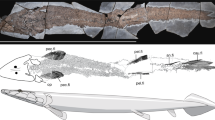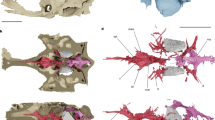Abstract
One of the identifying characteristics of tetrapods (limbed vertebrates) is the presence of fingers and toes. Whereas the proximal part of the tetrapod limb skeleton can easily be homologized with the paired fin skeletons of sarcopterygian (lobe-finned) fish, there has been much debate about the origin of digits. Early hypotheses1 interpreted digits as derivatives of fin radials, but during the 1990s the idea gained acceptance that digits are evolutionary novelties without direct equivalents in fish fin skeletons. This was partly based on developmental genetic data2, but also substantially on the pectoral fin skeleton of the elpistostegid (transitional fish/tetrapod) Panderichthys, which appeared to lack distal digit-like radials3. Here we present a CT scan study of an undisturbed pectoral fin of Panderichthys demonstrating that the plate-like ‘ulnare’ of previous reconstructions is an artefact and that distal radials are in fact present. This distal portion is more tetrapod-like than that found in Tiktaalik4 and, in combination with new data about fin development in basal actinopterygians5, sharks6 and lungfish7, makes a strong case for fingers not being a novelty of tetrapods but derived from pre-existing distal radials present in all sarcopterygian fish.
This is a preview of subscription content, access via your institution
Access options
Subscribe to this journal
Receive 51 print issues and online access
$199.00 per year
only $3.90 per issue
Buy this article
- Purchase on Springer Link
- Instant access to full article PDF
Prices may be subject to local taxes which are calculated during checkout



Similar content being viewed by others
References
Gegenbaur, C. Grundriss der vergleichenden anatomie (Wilhelm Engelmann, 1874)
Sordino, P., van der Hoeven, F. & Duboule, D. Hox gene expression in teleost fins and the origin of vertebrate digits. Nature 375, 678–681 (1995)
Vorobyeva, E. I. The role of development and function in formation of tetrapod-like pectoral fins. Zh. Obshch. Biol. 53, 149–158 (1992)
Shubin, N. H., Daeschler, E. B. & Jenkins, F. A. Jr. The pectoral fin of Tiktaalik roseae and the origin of the tetrapod limb. Nature 440, 764–771 (2006)
Davis, M. C., Dahn, R. D. & Shubin, N. H. An autopodial-like pattern of Hox expression in the fins of a basal actinopterygian fish. Nature 447, 473–476 (2007)
Dahn, R. D. et al. Sonic hedgehog function in chondrichthyan fins and the evolution of appendage patterning. Nature 445, 311–314 (2007)
Johanson, Z. et al. Fish fingers: digit homologues in sarcopterygians fish fins. J. Exp. Zool. (Mol. Dev. Evol.) 308B, 757–768 (2007)
Vorobyeva, E. I. Observations on two rhipidistian fishes from the Upper Devonian of Lode, Latvia. Zool. J. Linn. Soc. 70, 191–201 (1980)
Vorobyeva, E. I. & Schultze, H.-P. in Origins of the Higher Groups of Tetrapods: Controversy and Consensus (eds Schultze, H.-P. & Trueb L.) 68–109 (Cornell Univ. Press, 1991)
Boisvert, C. A. The pelvic fin and girdle of Panderichthys and the origin of tetrapod locomotion. Nature 438, 1145–1147 (2005)
Coates, M. I. The Devonian tetrapod Acanthostega gunnari Jarvik: postcranial anatomy, basal interrelationships and patterns of skeletal evolution. Trans. R. Soc. Edinb. Earth Sci. 87, 363–421 (1996)
Vorobyeva, E. I. Morphology of the humerus in the rhipidistian Crossopterygii and the origin of tetrapods. Paleontol. J. 34, 632–641 (2000)
Boisvert, C. A. in Forty Years of Early Vertebrates: Papers from the 11th International Symposium on Early and Lower Vertebrates (eds Ahlberg, P. E., Blom H. & Boisvert, C. A.) (Vol. Acta Zool. special volume, Blackwell, in the press).
Shubin, N. H., Tabin, C. & Carroll, S. Fossils, genes and the evolution of animal limbs. Nature 388, 639–648 (1997)
Gregory, W. K. & Raven, H. C. Studies on the origin and early evolution of paired fins and limbs. Ann. NY Acad. Sci. 42, 273–360 (1941)
Westoll, T. S. The origin of the primitive tetrapod limb. Proc. R. Soc. Lond. B 131, 373–393 (1943)
Andrews, M. S. & Westoll, S. T. The postcranial skeleton of Eusthenopteron foordi Whiteaves. Trans. R. Soc. Edinb. 68, 207–328 (1970)
Davis, M. C., Shubin, N. H. & Daeschler, E. B. A new specimen of Sauripterus taylori (Sarcopterygii, Osteichthyes) from the Famennian Catskill Formation of North America. J. Vert. Paleontol. 24, 26–40 (2004)
Daeschler, E. B., Shubin, N. H. & Jenkins, F. A. Jr. A Devonian tetrapod-like fish and the evolution of the tetrapod body plan. Nature 440, 757–763 (2006)
Long, J. A. et al. An exceptional Devonian fish from Australia sheds light on tetrapod origins. Nature 444, 199–202 (2006)
Jarvik, E. The Devonian tetrapod Ichthyostega . Fossils and Strata 40, 1–213 (1996)
Acknowledgements
We thank P. Ross and the team at East-Tallinn Central Hospital, Estonia for the CT-scanning, E. Vorobyeva for permission to examine the Panderichthys material in her care, N. Shubin for access to Tiktaalik, and M. I. Coates for valuable discussions. C.A.B. and P.E.A. are supported by Vetenskapsrådet.
Author Contributions E.M.-K wrote one of the Supplementary Information files and arranged the logistics for the CT scan, P.E.A. and E.M.-K. scanned the specimen, and C.A.B and P.E.A. produced the models and descriptions.
Author information
Authors and Affiliations
Corresponding author
Supplementary information
Supplementary Information
This file contains Supplementary Information about the localities, range and age dating of Panderichthys rhombolepis, Supplementary References and Supplementary Figure with Legend. (PDF 3737 kb)
Supplementary Movie 1
This file contains 360° rotation of the fin endoskeleton and pectoral girdle with translucent scale and lepidotrichia cover. (MPG 1820 kb)
Supplementary Movie 2
This file contains 360° rotation of the fin endoskeleton and pectoral girdle. Note that the scapulocoracoid is truncated anteriorly where the scan resolution became too poor to model due to mineral infill to confidently model. The supracleithrum and the scale and lepidotrichia cover end where the scan began and ended, respectively. (MPG 1812 kb)
Supplementary Movie 3
This file contains 360° rotation of the fin endoskeleton. (MPG 1814 kb)
Supplementary Movie 4
This file contains 360° rotation of the fin endoskeleton pausing in post-axial, dorsal, pre-axial and ventral views. (MPG 2015 kb)
Rights and permissions
About this article
Cite this article
Boisvert, C., Mark-Kurik, E. & Ahlberg, P. The pectoral fin of Panderichthys and the origin of digits. Nature 456, 636–638 (2008). https://doi.org/10.1038/nature07339
Received:
Accepted:
Published:
Issue Date:
DOI: https://doi.org/10.1038/nature07339
This article is cited by
-
A new elpistostegalian from the Late Devonian of the Canadian Arctic
Nature (2022)
-
Elpistostege and the origin of the vertebrate hand
Nature (2020)
-
Land Invasion by the Mudskipper, Periophthalmodon septemradiatus, in Fresh and Saline Waters of the Mekong River
Scientific Reports (2019)
-
Limb development: a paradigm of gene regulation
Nature Reviews Genetics (2017)
-
Characteristic tetrapod musculoskeletal limb phenotype emerged more than 400 MYA in basal lobe-finned fishes
Scientific Reports (2016)
Comments
By submitting a comment you agree to abide by our Terms and Community Guidelines. If you find something abusive or that does not comply with our terms or guidelines please flag it as inappropriate.



